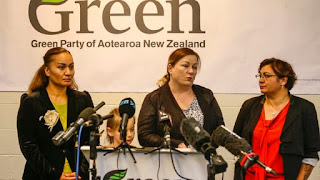Homelessness Finally Hits Middle NZ
It is likely that New Zealand hasn't experienced this level of homelessness and lack of decent housing since the depression. Even in 1905 the importance of state housing was recognised by Richard Seddon and his Liberal Government:
"...alarmed by growing reports of extortionate rents and squalid living conditions in the working-class districts of New Zealand cities, Seddon inteoduced the Worker's Dwellings Act. Its purpose was to provide urban workers with low-cost suburban housing, far removed from city slums and grasping landlords."
Up until 1991 the state housing stock grew to generally meet demand and totaled around 70,000 at peak. If we had continued on the same trajectory of state house building as we had from 1950 to 1990, we would have over 90,000 state houses now and a constant, ongoing, supply. Market rentals were brought in the 90s, around 8,000 state houses were sold off and underfunding has been the reality since. Well built state housing had created the supply of low cost housing for future generations and the state houses of the 40s are still seen as solid options for private owners compared to the leaky buildings of the deregulated 90s. The majority of new houses are being built for the affluent and we are consequently ranked third in world for the size of our homes.
Given that it is now common for multiple families to squeeze into a one three bedroom house and how many are forced to pay up to $400 a week to live in a garage, it does seem as though we have a back to the future scenario.
This Government has known since 2008 what the previous Labour Government had begun to address, New Zealand was falling behind in meeting the growing demand for social housing. Report after report has crossed the desks of National Ministers detailing the needs and describing system failures and have been deliberately ignored. The numbers of those on Housing NZ urgent waiting lists continued to grow despite tightening the criteria and it can now take up to two years to address an urgent housing need.
This populist Government understands that to remain in power it must retain the support of middle New Zealand. It has deliberately sought to spin the realities of welfare failures so that greater levels of tolerance for poverty can be achieved and less spending is necessary. The Government has been hugely successful as they have managed to restrict the funding and drastically reduce the capacity of the country's main provider of social housing.
Middle New Zealand have accepted the spin that the 43%+ of Pasifika families live in over-crowded homes because that is a cultural choice. Middle New Zealand comfortably swallowed the explanation that a large percentage of Housing NZ stock was not fit for purpose as it was the wrong size or in wrong place (despite the refusal to support the claim with evidence). Middle New Zealand largely accepted the suggestion that the Government is ill equipped to manage social housing (despite it doing so successfully from the 1930s to the 1980s). Middle New Zealand also appears to agree that our housing shortage is because city councils are not providing enough land for developers.
Middle New Zealand did not have first hand experience of the deliberate underfunding of state house maintenance (now estimated at $1.5 billion). The demand that the Housing NZ pay a $118 million dividend was generally accepted and the explanation that the dividend was necessary to "place a discipline" on the crown entity went without a protest from middle New Zealand.
Those protesting at the removal of state houses from prime real estate in Glen Innes were largely condemned by middle New Zealand and yet the 156 state rentals were going to be replaced by only 78. The plan to sell all the 1,500 state housing in Tauranga and Invercargill has not met large protests as middle New Zealand felt comfortable with the plans and those who were directly impacted were too frightened to say anything (trouble makers are likely to find themselves homeless).
There was some feeling of discomfort when it was revealed that the poor condition of a state house was implicated in the death of a young child, but it was presented as a maintenance issue rather than the tip of an iceberg. The 50,000 children who are being hospitalised annually because of poor quality housing mainly passed under the radar as these are not the children of middle New Zealand. I have heard it said that the problems are more likely to be caused by poor house management than a problem with the house itself as much of middle New Zealand has experienced living in uninsulated homes and survived. They forget that heating was cheaper, overcrowding wasn't an issue and many mothers stayed at home and kept the house warm during the day. Blaming the poor for their situation is encouraged amongst middle New Zealand.
The Green Party's announcement of a new policy to address the housing crisis included the plight of a mother who did not fit the generic picture of someone needing social housing. This mother was white and was obviously educated and articulate. She had been married and employed but a marriage failure and having to leave work to care for her seriously ill daughter had reduced her income and she found herself homeless. She needed to remain in Auckland to be close to the Starship Hospital but couldn't find anywhere to live. She could no longer adequately care for her sick child and nothing would be available for almost two years. Her only current option is her car.
Middle New Zealand is beginning to take notice...




Comments
A number of people have suggested quality prefabricated houses where the main construction can be be monitored more easily and automated building will be more cost effective. I think they do this well in Scandinavia:
http://swedishhouses.com/key-facts-timber-framed-homes
National has got a very slick PR machine and its Crosby Textor influenced approach is very effective, no matter how dishonest and hopeless they are they can ride through a crisis with glib putdowns and childish reactions that Trump has found useful. Nothing will happen regarding a change of government until middle new Zealand decides enough is enough. Obviously the opposition has a role in that but the strength of any opposition is also dependent on strong people joining them to make them more effective.
I also acknowledge that it is hard to stand up to this Government. Many I know have been attacked by the likes of Slater and others (including myself) and had their character questioned and dragged through the mud because they care about education or healthy food or want stricter controls on alcohol. Nicky Hager had his home raided, his equipment taken and even his daughter was targeted. It is so much easier to just concentrate on living day to day, pay off the mortgage and be thankful that one has a house.
I do put the responsibility for where we are on middle New Zealand because unless they become more informed and care more the status quo will remain. It is middle New Zealand who voted this Government into power, it is middle New Zealand who largely fill the ranks of our opposition. The rich do well under National and the poor become more powerless, it is down to middle New Zealand to collectively do something.